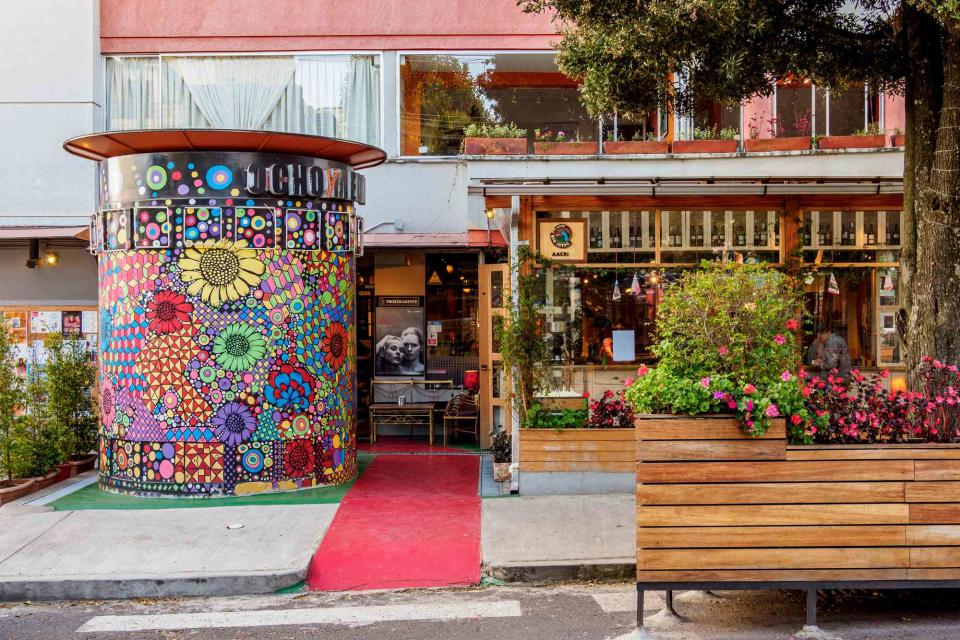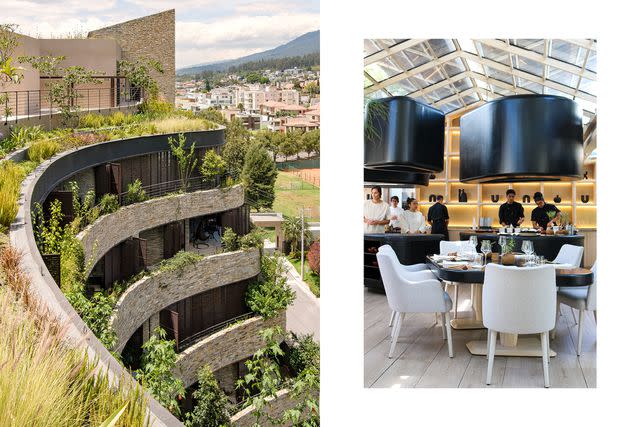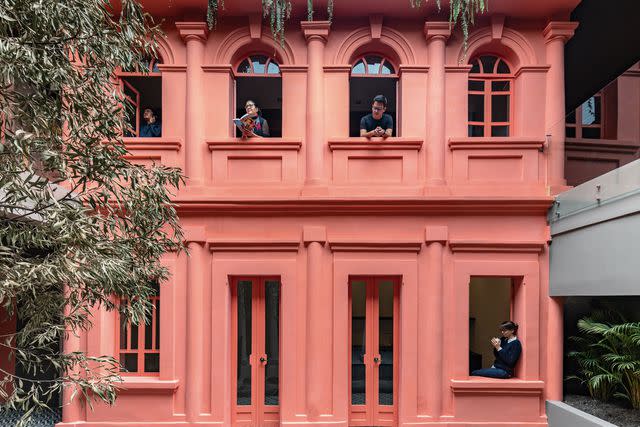The Creative Scene in Quito, Ecuador, Is Booming — These are the Some of the Best Places to Visit
The high-altitude city is still a fantastic gateway to the Galápagos Islands, too.

Karol Koslowski/Alamy
Ochoymedia, a movie theater in Quito's arty La Floresta neighborhood.In 2011, after more than a decade working and living in Paris and New York City, architect Mathieu de Genot returned to his hometown of Quito, Ecuador. At the time, the city felt quiet, remote, and more or less off the map in the eyes of the rest of the globe. “The joke we always used to make about Quito is that we’re in the middle of the world, but also in the middle of nowhere,” Genot told me.
Sitting 9,350 feet above sea level, Quito is the second-highest-altitude capital on the planet (the first is La Paz, Bolivia). It feels every bit as vertiginous as you’d expect: forested hillsides stand next to rampant informal development; shining glass towers jockey for space with 17th-century churches. For most of its recent history — or at least since 1959, when Ecuador first declared the Galápagos Islands a national park — the seat of government has been something of an afterthought for travelers, a waypoint en route to the ecological wonderland off the coast. But Quito is stepping up as a hot spot for design, food, and more. “People didn’t really know where we were before,” Genot said. “Now they’re finally finding out.”
The same extreme location that kept the place so isolated for so long (and that can still flummox visitors: foggy from altitude sickness, I lost my phone on the day I arrived) has also helped Quito cultivate a unique identity. “It’s the mountains. It’s the colors. It’s the beauty you see in the folk art here,” said Margara Anhalzer, who presides over a curious corner of Quito’s living history as the director of Olga Fisch Folklore. In 1939, the artist and designer Olga Fisch, Anhalzer’s great-aunt, left her native Hungary and eventually settled in Quito, joining a small band of other émigrés sheltering from the Nazis. After immersing herself in Indigenous craft traditions, she began collecting both pre-Columbian and colonial art. She also sold pieces by regional artisans alongside her own Modernist textiles and jewelry.

From left: From left: Bicubik/Courtesy of Uribe Schwarzkopf; Gabriela Salinas/Courtesy of Foresta
From left: Aquarela, a residential project by architect Jean Nouvel in Quito's Cumbayá suburb; the main dining room at Chef Rodrigo Pacheco's Foresta has a glass roof.Today, under her grandniece’s management, Fisch’s shop and museum remains very much open. On my visit, Anhalzer guided me through exhibits of colorful folk and folk-inspired artifacts, all packed into Fisch’s former home in the La Floresta district, long a redoubt of the city’s creative class.
“It’s a very traditional neighborhood that’s also a point where the old and the contemporary meld,” said Rodrigo Pacheco, arguably Ecuador’s highest-profile chef de cuisine (thanks chiefly to his turn on the Netflix show The Final Table). Pacheco chose the artsy enclave as the site of his latest venture, even making its name a pun on the place. Foresta opened just last year, and its avant-garde approach to traditional Ecuadoran fare amounts to a deluxe nationwide tour: buñuelos are topped in ice cream flavored with cinnamon-like ishpingo; cocktails feature the mysteriously rhubarb-ish naranjilla fruit; pork cracklings and sweet potatoes complement a cuttlefish, its ink pooling around the plate in surrealist-looking blotches.
All of this is served up in a suitably forest-like atmosphere. The restaurant’s high-ceilinged interior brims with exotic plants under a greenhouse roof, its organic elements tempered by an ultra-cool palette of white and black. “I wanted it to be like an encounter with art — inside a jungle,” said Foresta’s designer, Felipe Escudero.
For those who favor a more traditional architectural aesthetic, the best place is Quito’s historic center — though even there, surprises abound. Just a short walk from the looming neo-Gothic towers of the Basílica del Voto Nacional, I stumbled on Casa Anabela. Opening a door in a blank street wall, I found myself in the hotel’s elegant courtyard, which has a grand focal point: a 19th-century façade, painted a vibrant pink. A few blocks away, the Carlota, which opened in 2016, pulls a similar trick, its ornate Beaux-Arts front giving way to a hip, minimal interior. The hotel’s subdued-yet-glam rooftop bar is topped with a shade-giving awning that doubles as a solar panel, using the hot equatorial sun to help power the building.

JAG Studio/Courtesy of nicolas&nicolas
Casa Anabela, a hotel in Quito's historic center that opened in 2021, partly occupies a brightly painted 19th-century building.Perhaps the surest indicator of Quito’s current trajectory is the skyline, which has been marching straight upward in recent years, with no signs of slowing. For architecturally minded tourists like me, driving through the city — slowly, traffic being a chronic issue — means running into familiar names at every turn: Bjarke Ingels (two apartment buildings, the boxy Iqon and curvaceous Epiq); Moshe Safdie (the Qorner tower, on the edge of the scenic Parque La Carolina); and perhaps most remarkably, Jean Nouvel, whose Aquarela, in the suburb of Cumbayá, is as large and ambitious as any residential project the Pritzker Prize winner has ever devised.
“The design really draws on the surrounding vegetation, and on the volcanic landscape of the area,” said the architect Alberto Medem, who also worked on Aquarela. At first, the complex looks less like a piece of architecture than a geologic formation: irregular, terraced monoliths thrust out of the earth with greenery-filled courtyards between them. The first stage of the development, including half of its projected 600 apartments, was completed late last year. It lures tenants not just with its architectural pedigree but also with a suite of amenities worthy of a luxury cruise ship, from squash courts to a bowling alley to, incredibly, an indoor ice-skating rink.
What’s going up certainly proves Quito’s vaulting aesthetic ambition — but in its bid for global status, what’s happening below street level is no less important. As I descended a hundred feet or more beneath the historic Monestario de San Francisco, I got a sneak peek at the centermost station of the city’s long-awaited subway system, which will provide Quiteños with a much-needed alternative to the clogged streets. (Construction is ongoing, though it began limited service this past April.) Practical though it is, the San Francisco stop also has style to spare, with an aboveground portion carved out of a colonial villa and gleaming platforms that borrow from Milan’s famously mod Metro.
“It’s an answer not only to our mobility and transport issues,” said the Quito Metro’s director of operations, Roberto Custode. “It’s an opportunity for change.” With so much to see, and so many people bound to see it, the Metro seems to be arriving right on time, a perfect symbol for a city on the move.
A version of this story first appeared in the July 2023 issue of Travel + Leisure under the headline "Rising High."
For more Travel & Leisure news, make sure to sign up for our newsletter!
Read the original article on Travel & Leisure.

